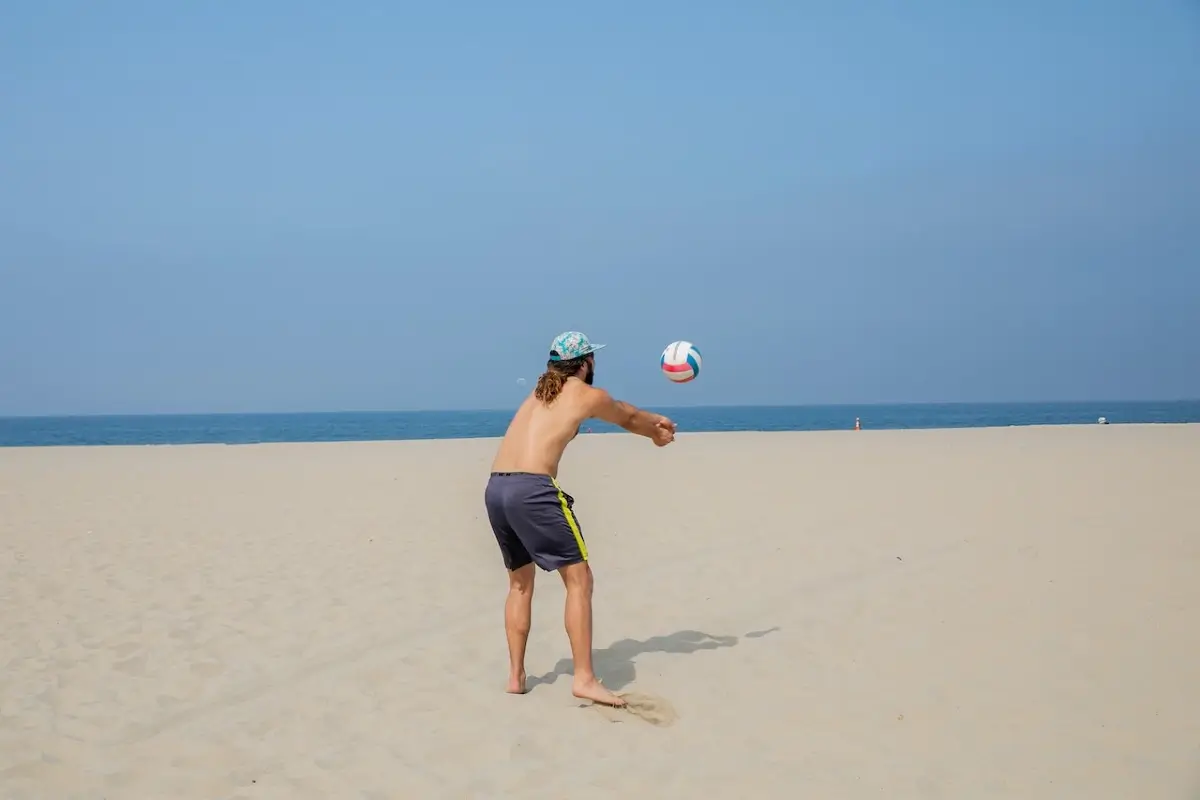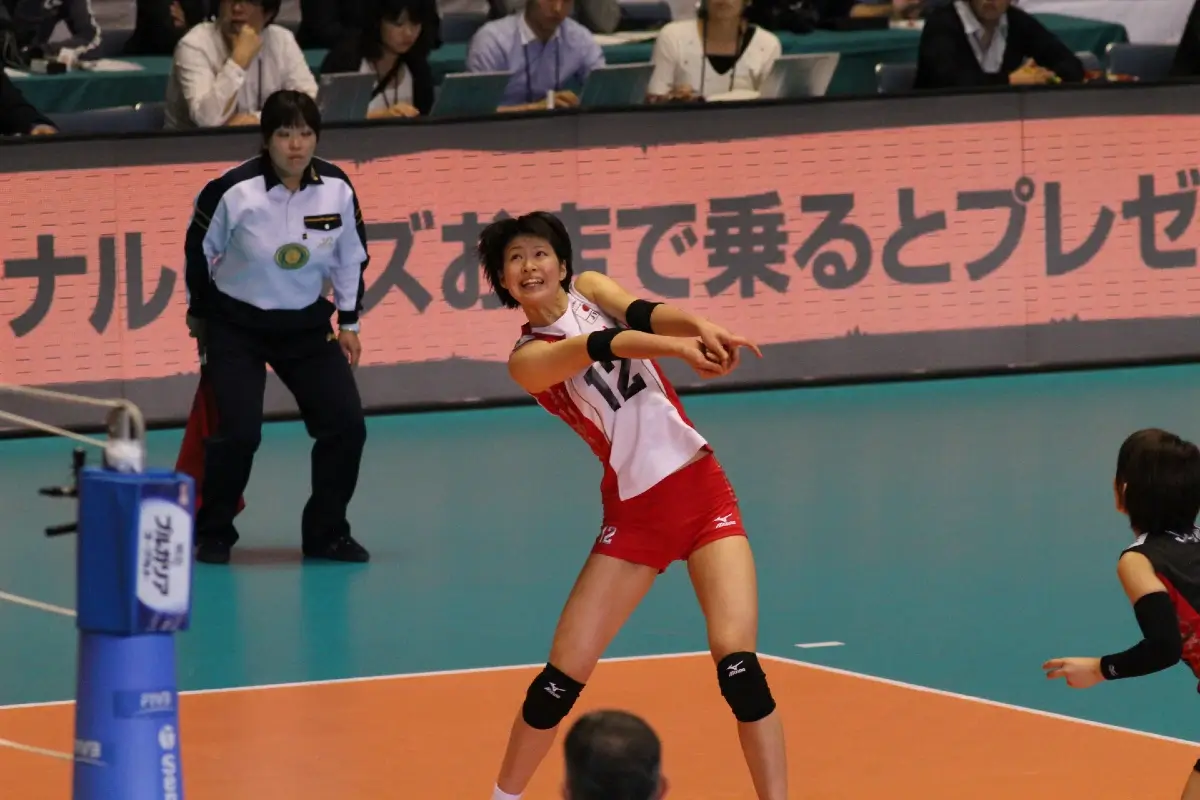Last Updated: January 12, 2024
An error most novices make is that they underestimate the importance of proper passing techniques when they first learn to pass. This negligence often serves as a roadblock to success on the court because it causes them to make a cascade of mistakes that hinder their performance as a player.
Subsequently, they miss out on the opportunity to contribute significantly towards the team’s success. To not squander all the valuable scoring opportunities on the volleyball court, you must pay attention to developing precise passing skills.
Let me unravel some essential techniques to master the art of passing.
Learning the Essential Techniques to Master Passing in Volleyball

Proper Stance
It all starts with having a balanced base. Your feet should be spaced apart at a shoulder-width distance. You must also have a slight bend in your knees. Additionally, you should lean slightly forward. In this ready stance, your body’s weight should be evenly distributed between both your feet.
Arm Positioning
For volleyball passing, you should position your arms in front of your body, forming a platform to connect with the incoming ball. The stability in this forearm position will come from holding your arms together with open palms and fingers spread apart. Your thumbs will make light contact with each other.
Don’t Swing your Arms
In a sport like volleyball, where the margin for error is small, you should not swing your arms during passes. Because of the introduction of unnecessary variables, arm swinging causes inconsistencies in passing. Swinging can also cause your arms to fatigue quickly, eventually impacting your passing ability.
Therefore, you must always provide a stable passing platform for the ball to connect so that it can bounce off nicely and predictably. In short, a stable platform without any arm swing will lead to more controlled and accurate passes.
Use Your Forearms
You must use your forearm area to pass the volleyball. The ball should not connect with your hands or wrist because the surface area would be too small for controlling the volleyball. On the other hand, the center of your forearms will provide a stable and larger platform for the ball to connect.
Leg Positioning
Your legs initiate movement on the volleyball court. So, your ability to remain quick on your feet will impact your passing skill execution. Ideally, you should stay on the ball of your feet in a slightly lowered body position. This will allow you to move swiftly in any direction (forward, backward, or lateral) without losing stability.
Wrist Positioning
To absorb the impact from the incoming ball, keep your wrist straight (neutral). To achieve this wrist position, focus on keeping your forearms in line with your knuckles. This will ensure that your wrist is not bending forward or backward during a pass. At the same time, keep your wrist flexible.
The key is to strike a balance between firmness and flexibility because too much wrist stiffness can cause irregularities in your passes. You will have to engage in wrist-positioning-focused drills to achieve the required wrist control for efficient volleyball passing.
Elbow Positioning
You should always maintain a slight bend in your elbows. Overly bent or completely straight elbows prevent us from achieving the flexibility and control needed for an accurate passing motion. You should not press your elbows against the body. Your elbows must be slightly away (a subtle gap) from your torso.
Move to Meet the Ball
As soon as the ball leaves the opponent’s hand, you should anticipate its direction and attempt to get under it as quickly as possible. Moving quickly will give you a split-second advantage to react to the incoming ball, enabling you to make a smoother and more controlled pass.
Move your Feet First
To set yourself up for accurate passing, you should always move your feet first before your arms or anything else. Moving your feet first will allow you to move quickly in the ball’s direction while maintaining proper balance. In other words, the feet-first approach will get you behind the ball quickly with the required stability.
Square up your Body
To execute effective volleyball passes, it’s essential that you align your arms, shoulders, and hips squarely toward the target. This position will optimize your body’s stance for successful volleyball passes. You will be able to adjust quickly according to the ball’s trajectory.
Aligning your body with the target also minimizes errors. You are less likely to direct the ball in an unintended direction, making it difficult for the opponents to score easy points against your team. When team players square up, it also improves team communication, allowing for smoother offense and defense.
Anticipate in Advance
To get a good head start, you should be proactive on the court. Proactive anticipation will not only allow you to get into an ideal passing position quickly, but it will also help you react quickly. Therefore, you won’t have to lunge or scramble for the ball, resulting in minimal passing errors.
Run with Arms Apart
The best way to reach the desired position swiftly is to run with your arms apart. It’s a key technique that will enable you to cover a lot of court area quickly. As a result, you will be able to get into the passing position sooner than usual. Running with your arms apart will also prevent you from leaning too forward or backward, enabling better stability and balance in the process.
Stop Before Passing
You need to stop momentarily before executing a pass because passing a ball in motion makes it difficult to control it, resulting in uncontrolled passes. In short, a pause before passing will lead to accurate passes. Pausing for a while will also give you some extra reaction time to make informed decisions in real-time.
Track the Ball
You should not look at the ball only when it starts approaching you. You should look at it as soon as the server gets the ball. This will allow you to make last-minute minor adjustments to pass the volleyball accurately. So, keep an eye on the ball throughout its journey.
Master the Finishing Position
To finish the pass, you must position your serve receive platform below your shoulders and not above your head. This finishing position will contribute towards a more accurate and consistent pass by minimizing risks of errors in your passing technique.
Communicate Well
Effective communication helps avoid collisions. It also ensures that the most suitable player takes the pass. So, it’s a vital part of the team strategy that prevents the game flow from getting disrupted. Using codes, verbal calls, or hand signals to indicate your intention will allow you to make accurate passes when other passers are in your close proximity.
Work on your Physical Fitness
Keep in mind that volleyball is a physically demanding sport. The better your overall physical fitness is, the better will be your volleyball skills, including your volleyball passing ability. Therefore, it’s important to prioritize your physical fitness. Ideally, a well-rounded fitness regime will help improve your strength, endurance, agility, mobility, and flexibility.
Seek Feedback
To master the art of passing, you should be open to criticism. After all, no player can improve without constructive criticism. So, let your coach review your passing skills. This will help you to make real-time adjustments as needed to fine-tune your passing technique.
Different Volleyball Passing Stance
The passing stance can vary depending on the game situation. Here are some of the common passing stances.
Standard Pass
For a standard pass, you must stand with your feet shoulder width apart along with a slight bend in the knees for agility. You will shift your weight on the ball of your feet. To create a platform with your forearms, you will hold the arms in front of you. To direct the ball at its intended target, elevate the forearm platform slightly upwards.
High Pass
To handle the ball above the shoulder height, a high passing position would be ideal. For a high pass, you will have the same stance as with the standard pass, with the exception that your arms will be positioned higher and not in front of your body at waist-to-chest height.
Low Pass
When the ball is close to the ground, you will use a lower stance. So, your knees and hips will bend more, allowing you to bend your body in a deep squat position while keeping the forearm platform technique intact.
Front Set Pass
The front set passing stance will be the same as the standard pass. The only difference is that the front set pass is employed for setting up an attack. On the other hand, the standard pass is used primarily for serving and passing.
Back Set Pass
In this pass, you will direct the volleyball behind you and not in the front. That said, the stance will be the same as the front set. You will just modify your body positioning to send the ball backward.
Diving Pass
To prevent a fast and low ball from hitting the ground, the diving pass is executed. For this movement, you will lunge forward and extend one arm flat along the ground, with the goal of having the ball bounce off your hand.
Best Drills to Improve Your Volleyball Passing Skills

Let’s now explore some of the best drills to improve your volleyball passing skills. When practiced regularly, these drills can prepare you to handle any pass coming your way.
Serve Receive Drill
The main objective of the ‘Serve Receive’ drill is to improve your passing accuracy. In this drill, a server will deliver the volleyball to you, enabling you to practice executing a pass with precision. Once the setter serves the ball, you will focus on directing the ball back to the server or the intended target with precise forearm positioning.
To mimic real game situations, you will constantly rotate your positions on the court. Game-live serves from various positions will really hone your abilities to excel in passing skills. This drill will also improve your reaction time. The best part is that it will foster a team environment because of the effective communication between the server and the receiver.
See other receiving drills here
Shadow Blocking Drill
This is another wonderful drill that stimulates real-game scenarios to help one enhance their volleyball passing skills. In this drill, a blocker will be set close to the net with his hands raised to defend the ball, almost replicating the stance of a blocker during an actual game.
A passer will aim to skillfully navigate the blocking obstruction by directing the ball to the setter or the intended target. You will become a lot more versatile than before by performing this drill on a regular basis because the drill requires practicing around a person blocking your pass. So, your ability to handle blocking obstacles will improve drastically.
Passing Progression Drill
This drill works great for learning the foundational technique of executing passes with proper forearm use. It starts with close-range passing practice with a teammate. As you get proficient with close-range passes, you will move apart from your partner to make the exercise more challenging.
While passing the ball, you should focus on keeping your wrist neutral. It should be firm but not too rigid. Throughout the drill, your forearm should be flat and steady. As you adapt to training from a longer distance, you can increase the velocity of the passes to build a much stronger volleyball passing foundation.
Word of Advice
You should never neglect skill training. If you stop practicing, you risk losing the acquired skill. You won’t go back to square one, but the acquired skills will degrade. Plus, you won’t learn new strategies and techniques. Therefore, it’s important to keep prioritizing skill training to continually enhance your volleyball passing.
Conclusion
The journey to mastering the art of passing won’t be an easy one. Like any other skill-learning process, there will be moments of frustration and setbacks. However, each challenging situation will help you grow.
As you continue with the learning phase, you will also realize that the thrill of contributing to your team’s success will make all your efforts worthwhile in the end.
